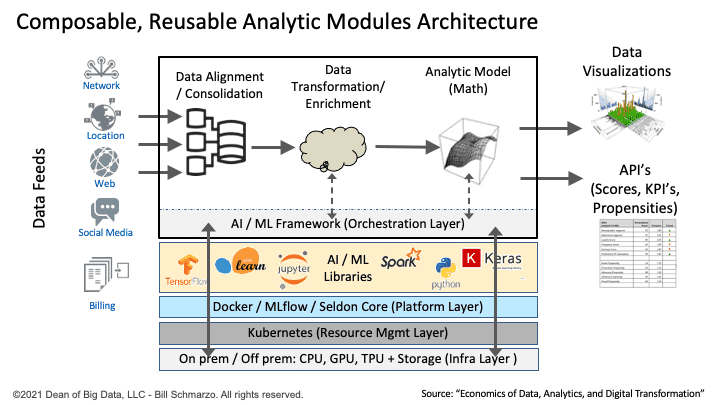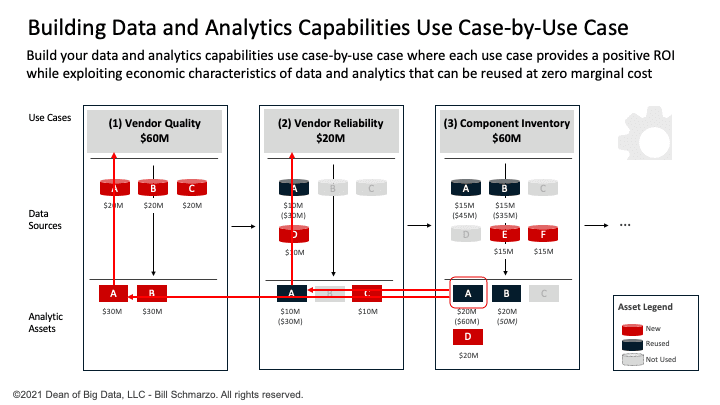
With a potential recession lurking on the horizon, 99% of companies will make the same old “safe” mistakes: hunker down, let people go, shrink, and hope to hold on for dear life. However, growth-oriented organizations will see this as a business opportunity – an opportunity to leverage their data to “do more with less”. You see, data is an asset that all companies already possess. The problem is that most companies just don’t seem to know what to do with their wealth of data.
A recession provides a business incentive to exploit one’s data to uncover and act upon (monetize) the customer, product, service, and operational insights (individualized predicted behavioral and performance propensities) buried in their data. For growth-oriented organizations, this means leveraging Nanoeconomics to drive Precision Decisions to retain their most important customers, sweep up their competitors’ most important customers, amass market share, create new revenue opportunities, and optimize or even re-invent key business and operational processes, procedures, and policies.
For those companies who want to exploit a recession as a business opportunity, here is the Data and Analytics Recession Playbook of actions you can take TODAY to make your data work harder, and smarter, in the mission to “do more with less.”
Recession Play #1: Drive Organizational Align on Use Cases
Don’t start the playbook by talking about data or analytics or AI or machine learning. Instead, let’s talk about where and how your organization creates value and how it measures its value creation effectiveness. And that means talking Use Cases.
Immediately rally the troops to drive cross-organizational collaboration to identify, validate, value, and prioritize those Use Cases where the application of data and analytics can materially improve customer outcomes or operational efficiencies over next 12 months. Exploit the recession to create a sense of urgency to drive organizational consensus and alignment on a “Do more with less” data and analytics path forward.
Key activities for Play #1:
- Bring together a diverse set of stakeholders – stakeholders who either impact or are impacted by the use case – to understand why this use case is important to them (business benefits) and the KPIs and metrics against which use case effectiveness will be measured.
- Quickly gain organizational consensus on the KPIs and metrics against which the Use Case business outcomes effectiveness will be measured.
- Note: ideal Use Cases should deliver one or more of the following business outcomes:
- Increase revenues and market share
- Reduce costs and expenses
- Improve marketing and promotional effectiveness
- Increase operational productivity
- Reduce regulatory and compliance risks
- Increase customer satisfaction and Likelihood to Recommend
- Increase employee productivity and satisfaction
- Expand partner and channel effectiveness
- Reduce waste
- Reduce fraud
Use the Use Case Template in Figure 1 to formally define and scope your use cases.

Figure 1: Thoroughly Document Your Targeted Use Case
Recession Play #2: Prioritize Use Cases that Share Common Data Sets
Because one can reuse prepared, curated, and sharable data at near zero marginal cost, prioritize those use cases that share common data sets (to exploit the economics of data). For example:
- In Retail and Entertainment: Point of Sales + Customer Loyalty + Inventory data can be integrated to improve merchandising, sales, marketing, inventory, and store management effectiveness
- In Manufacturing and Oil & Gas: Machine telemetry + Service Records + Technician Notes can reduce unplanned operational downtime, reduce inventory costs, reduce rework, and improve technician productivity
- In Healthcare: Patient Medical Records + Physician/Nurse Notes + Patient Comments can be integrated to reduce unplanned readmissions, reduce days hospital stays, reduce hospital acquired infections, and improve quality of healthcare
- In Financial Services: Financial Transactions + Customer Care + Social Media data can be integrated to reduce customer churn, improve customer cross/up-sell, accelerate new product introductions, and improve customer advocacy and likelihood to recommend.
- In Higher Education: Student Performance + Teacher / Counselor Comments + Social Media data can be integrated to improve student retention, improve ideal prospect targeting, improve student acquisition, improve 4-year graduation rates, increase student and facility satisfaction, and future donations and lifetime giving.
The Prioritization Matrix is your friend for quickly coming to a cross-organizational consensus on clusters of related use cases (Figure 2).

Figure 2: The Prioritization Matrix
Recession Play #3: Empower the Frontlines of Your Organization
The best ideas as to where and how data and analytics can be applied to the business TODAY will NOT come from senior or middle management. Those folks are too far removed from the customer and operational action. Instead, leverage design thinking concepts and techniques to Empower front-line team members to ideate where and how data and analytics can improve the customer experience and drive operational efficiencies. That includes:
- Train everyone in the organization to “Think like a data scientist” (yea baby!) in ideating areas of the business where data and analytics might have a material impact on business and operational outcomes (Figure 3).
- Beyond just training, also Democratize Ideation by Empowering the frontlines with the authority and responsibility for applying data and analytics to improve decision-making in a rapidly changing customer and operational environment.

Figure 3: “The Art of Thinking Like a Data Scientist”
Recession Play #4: Embrace Nanoeconomics to Drive Precision Decisions
The “Do more with less” mandate will require making more informed decisions that deliver improved business and operational outcomes but with less resources. If you use the traditional averages-based decision making, at best, you’ll end up with average results. And being a “C” performer is not the way to thrive during a recession (or under any economic condition).
Instead, leverage data and analytics to make Precision Decisions that deliver more relevant customer, product, service, and operational actions leveraging the concept of Nanoeconomics – the economics of individualized entity (human or device) predicted behavioral and performance propensities (Figure 4).
- Leverage individual entity Predicted Propensities (predicted behavioral and performance tendencies) to make highly targeted, more relevant decisions.
- Have your data science team embrace nanoeconomics by building Analytic Profiles used to optimize your top priority business and operational use cases.
- Create Analytic Profiles to capture, codify, and enable the sharing of the individualized predictive behavioral and performance propensities (features and analytic scores) of your most important business entities (e.g., customers, products, employees, suppliers, turbines, trucks, trains, compressors, hydraulic presses) that can drive precision decisions in support your top priority use cases.
- Train the organization to make decisions based upon individualized entity predicted behavioral and performance propensities, instead of making decisions on generalized averages.

Figure 4: Nanoeconomics to Drive Precision Decisions
Recession Play #5: Engineer Composable, Reusable Data and Analytic Assets
Getting your data and analytics to work harder and smarter requires engineering your data and analytics as composable, reusable assets that can be easily shared, reused, and continuously refined. Key concepts for Play #5 include:
- Data is a unique economic asset – an asset that never depletes, never wears out, and can be used across an unlimited number of use cases at near zero marginal cost.
- Analytic assets can actually appreciate, not depreciate, in value – more reliable, more accurate, more predictable, and more relevant – the more that they are used.
- Data silos (data that cannot be easily shared and reused across the organization) and orphaned analytics (analytics built for a one-off business need but never engineered to continuously learn and adapt) are the great destroyers of the economics of data and analytics.

Figure 5: Composable, Reusable, Continuously-Learning and Adapting Analytic Modules
Recession Play #6: Build Data and Analytics Capabilities Use Case-by-Use Case
The final play is to incrementally build your data and analytics capabilities on a use-case-by-use-case basis where each use case delivers a positive Return on Investment (ROI). Avoid “big bang” data and analytics projects that take years to execute and even longer for which to realize business and operational benefits. During a recession, you don’t have years to wait for the payback.
Factors to consider as you incrementally build your data and analytic capabilities:
- Make sure that you have established enterprise-wide data management and governance policies and procedures that incentivize and mandate the sharing of data across the organization. The inability to share data and analytics across the organization delays use case time-to-value and increases implementation risks.
- The concept of data mesh holds the potential to incrementally build out your data and analytics architecture, though there are still execution learnings to be worked out to get the synergy of decentralized AND centralized data and analytics management capabilities.
- Each use case not only delivers a positive ROI, but also prioritizes the organization’s data and analytics assets based upon their ability to deliver meaningful, relevant, quantifiable business outcomes.

Figure 6: Building Your Data and Analytics Capabilities Use Case-by-Use Case
Recession Playbook Summary
Does it seem like an overly short list? Yep, because you ain’t got time for green bananas. The time to act is now and wasting time building the perfect data and analytics strategy will only guarantee your accelerated path to irrelevance.
